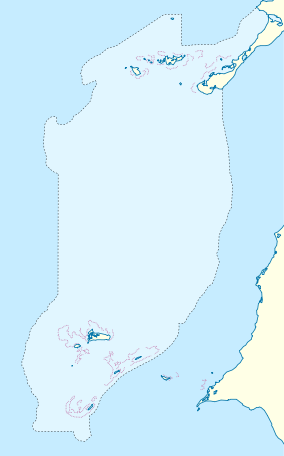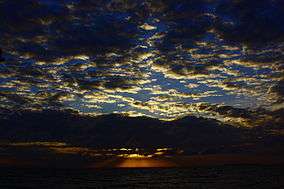Rosario and San Bernardo Corals National Natural Park
| Parque Nacional Natural Corales del Rosario y San Bernardo | |
|---|---|
| Rosario and San Bernardo Corals National Natural Park | |
|
IUCN category II (national park) | |
|
Dawn in Tintipán | |
 | |
| Nearest city | Tolú, Colombia |
| Coordinates |
10°10′N 75°45′W / 10.167°N 75.750°W Islas del Rosario 09°45′N 75°51′W / 9.750°N 75.850°W Islas de San Bernardo |
| Area | 1,200 km2 (460 sq mi) |
| Established | May 1977[1] |
| Governing body | SINAP |
The Rosario and San Bernardo Corals National Natural Park (Spanish: Parque Nacional Natural Corales del Rosario y San Bernardo) is a natural park located in the Sucre and Bolívar Departments on the coast of the Caribbean Region of Colombia, 45 km from the Bay of Cartagena. It was the most visited national park in Colombia in 2009, with 318,473 visitors.[2]
Most of the park is underwater[3] and it mainly protects marine ecosystems, including coral reefs[4] living on depths ranging from one to 30 meters.[5]
General
It is Colombia's only underwater park,[5] and one of three national parks in the Colombian Caribbean with coral reefs on its territories, the other two being Tayrona and Old Providence McBean Lagoon.[6]
It was established in 1977 to protect the coral reef on one of the islands in the Islas del Rosario archipelago, originally extending 178 km2 (69 sq mi). In 1988, an area of 195 km2 (75 sq mi) was incorporated, and finally in 1996 the park was expanded to the present area, 1,200 km2 (460 sq mi), including Archipelago of San Bernardo.[7]
The park is molded by the Caribbean and Panama currents, as well as freshwater from Canal del Dique.[8] Sediments brought from Magdalena River by the channel is having a negative effect of the park, as it deteriorates the reef.[8] There are no bodies of freshwater in the park, but there is brackish water in some of the lagoons on the islands.[3] Average yearly temperature is 27–30°C.[4]
Flora and fauna
Most of the wildlife is marine.[3] The park is home to 170 species of fish,[5] 52 corals, 25 sponges, hundreds of molluscs and crustaceans.[9] The flora is characterized by mangroves and seagrass beds.[10]
Footnotes
- ↑ IUCN 1982, p. 148
- ↑ "Parque Corales del Rosario es el más visitado en Colombia" (in Spanish). El Tiempo. Retrieved 11 July 2010.
- 1 2 3 "Naturaleza y Ciencia del Parque Nacional Natural Corales del Rosario y San Bernardo" (in Spanish). Parques Nacionales Naturales de Colombia. Retrieved 10 July 2010.
- 1 2 "Parque Nacional Natural Corales del Rosario y San Bernardo" (in Spanish). Parques Nacionales Naturales de Colombia. Retrieved 10 July 2010.
- 1 2 3 "Parque Nacional Natural Corales del Rosario y San Bernardo" (in Spanish). Terra Networks. Retrieved 11 July 2010.
- ↑ Cortés 2003, p. 296
- ↑ Restrepo Ángel 2005, p. 238
- 1 2 Villegas & Sesana 2007, p. 77
- ↑ Woods 2008, p. 49
- ↑ Restrepo Ángel 2005, p. 236
References
- IUCN (1982), IUCN directory of neotropical protected areas (in Spanish and English), IUCN, ISBN 978-0-907567-62-2.
- Restrepo Ángel, Juan Darío (2005), Los sedimentos del río Magdalena: reflejo de la crisis ambiental (in Spanish), Universidad Eafit, ISBN 978-958-8173-90-0.
- Villegas, Benjamin; Sesana, Laura (2007), Colombia Natural Parks, Villegas Asociados, ISBN 978-958-8156-87-3.
- Cortés, Jorge (2003), Latin American coral reefs, Gulf Professional Publishing, ISBN 978-0-444-51388-5.
- Woods, Sarah (2008), Colombia, Bradt Travel Guides, ISBN 978-1-84162-242-2.
